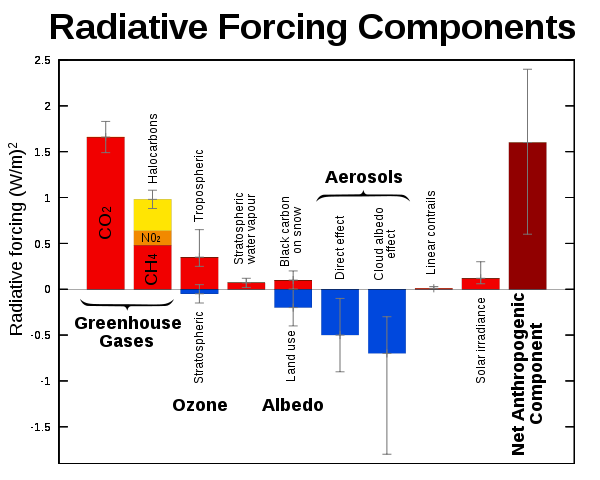Radiative forcing
The natural greenhouse effect isn't technically a radiative forcing to learn more about how the greenhouse effect changes the Earth's temperature click here.
Radiative forcing is the difference between incoming solar radiation and outgoing terrestrial radiation. This power, and thus the difference, is measured in watts per meter squared. Radiative forcing is considered instantaneous if stratospheric temperature changes aren't accounted for.[1] Earth absorbs power from the Sun and then eventually emits power back into space. The more power the Earth absorbs, the warmer it gets. The warmer the Earth is, the more power it radiates into space. This allows the Earth to sit at some equilibrium temperature. This temperature is set by various Climate forcing factors. Humans have been changing these forcing factors which is leading to changes in the climate system.
When climate forcings result in incoming power being greater than outgoing power, the planet warms. If outgoing energy is greater, the planet cools.[2] Thus, the general expression for radiative forcing is:[3] Eventually this warming or cooling sets a new equilibrium temperature for the planet. The biggest recent change in radiative forcing has been the dramatic increase in greenhouse gases in the atmosphere, but this is not the only one!
where radiative forcing can be a positive or negative value. These positive or negative values can be seen in Figure 1. The means by which this balance is induced - what exactly it is that causes an imbalance in the net power coming into and leaving the Earth - is known as a radiative forcing mechanism. More explicitly, the process that alters the energy balance of the Earth-atmosphere system (when the radiative forcing value is zero) is known as a radiative forcing mechanism. There are a large number of different types of variations, but they can include external forcings from variations in the Sun or Earth's orbit, or internal forcings such as a change in volcanic activity or in atmospheric composition. However, connecting a cause with some climate change is extremely difficult, especially because the climate system is incredibly interlinked. This connection results in climate feedbacks and changes propagating throughout the climate system, making direct associations difficult.[4]

Radiative vs. Non-Radiative Forcing
In addition to radiative forcings, there are also non-radiative forcings. The main difference that can distinguish the two is whether or not they involve some change in Earth's energy budget. Non-radiative forcings, unlike radiative forcings, cause a change in climate that involves an energy redistribution within the climate system. Since these forcings do not directly affect the balance between incoming solar radiation and outgoing radiation they cannot be considered radiative.
Additionally, non-radiative forcings usually act over a larger time scale than radiative forcings. While radiative forcings can result in noticeable changes within a generation, non-radiative forcings tend to act over larger time scales. In addition, many of these non-radiative forcings affect climate by changing the shape of the Earth's surface as a result of changing mountain ranges and ocean properties.[6]
Changes in Radiative Forcing
Before the Industrial Revolution in 1750, the average value for radiative forcing remained essentially stable. Scientists are able to document how the atmosphere has changed since then by calculating current values as if the radiative forcing value were zero in 1750.[7] By calculating it like this, it becomes clear that the value has increased significantly. In 1950, the value relative to 1750 was determined to be 0.57 W/m2. After only 30 years in 1980, the value had jumped again to 1.25 W/m2. The trend of rapid increasing has continued since then, with 2011 values reporting a radiative forcing value of 2.29 W/m2 relative to 1750.[3] Since 1750, anthropogenic or human-caused climate forcings have been increasing, and have thus been increasing the radiative forcing value.
Climate scientists have come up with four different possible scenarios for the future climate. Each scenario is modeled to show one possible pathway for how emissions of greenhouse gases could continue in the future. Each of these scenarios provides a predicted radiative forcing value. For example, if no changes are made to minimize greenhouse gas emission by 2100 the radiative forcing value is predicted to be 8.5 W/m2. In contrast, predictions that go along with a minimization of greenhouse gas emissions predict a value of only 2.6 W/m2.[3]
For Further Reading
- Greenhouse effect
- Climate
- Earth's energy budget
- Solar radiation
- Natural vs anthropogenic climate change
- Or explore a random page
References
- ↑ IPCC, 2012: Glossary of terms. In: Managing the Risks of Extreme Events and Disasters to Advance Climate Change Adaptation [Field, C.B., V. Barros, T.F. Stocker, D. Qin, D.J. Dokken, K.L. Ebi, M.D. Mastrandrea, K.J. Mach, G.-K. Plattner, S.K. Allen, M. Tignor, and P.M. Midgley (eds.)]. A Special Report of Working Groups I and II of the Intergovernmental Panel on Climate Change (IPCC). Cambridge University Press, Cambridge, UK, and New York, NY, USA, pp. 555-564.
- ↑ CORE. (November 7, 2015). Radiative Forcing [Online]. Available: http://www.co2offsetresearch.org/aviation/RF.html
- ↑ 3.0 3.1 3.2 NOAA Climate. (November 7, 2015). Climate Forcing [Online]. Available: https://www.climate.gov/maps-data/primer/climate-forcing
- ↑ Global Climate Change. (November 7, 2015). Radiative Forcing [Online]. Available: http://www.global-climate-change.org.uk/2-3.php
- ↑ Wikimedia Commons. (November 7, 2015). Radiative Forcing [Online]. Available: https://upload.wikimedia.org/wikipedia/commons/thumb/b/bb/Radiative-forcings.svg/600px-Radiative-forcings.svg.png
- ↑ Global Climate Change. (November 7, 2015). Non-Radiative Forcings [Online]. Available: http://www.global-climate-change.org.uk/2-2.php
- ↑ US EPA. (November 7, 2015). Radiative Forcing [Online]. Available: http://www3.epa.gov/climatechange/science/indicators/ghg/climate-forcing.html

